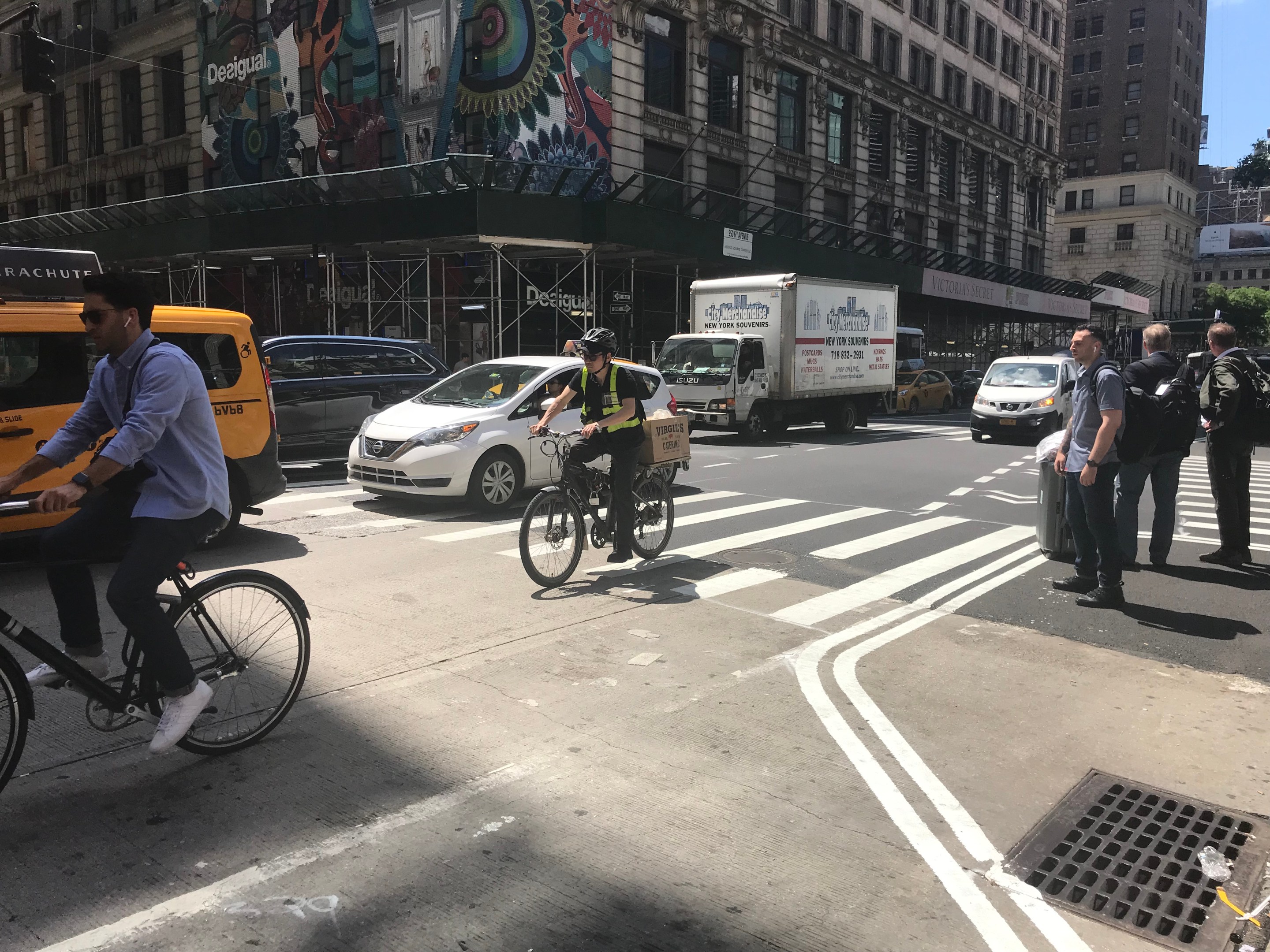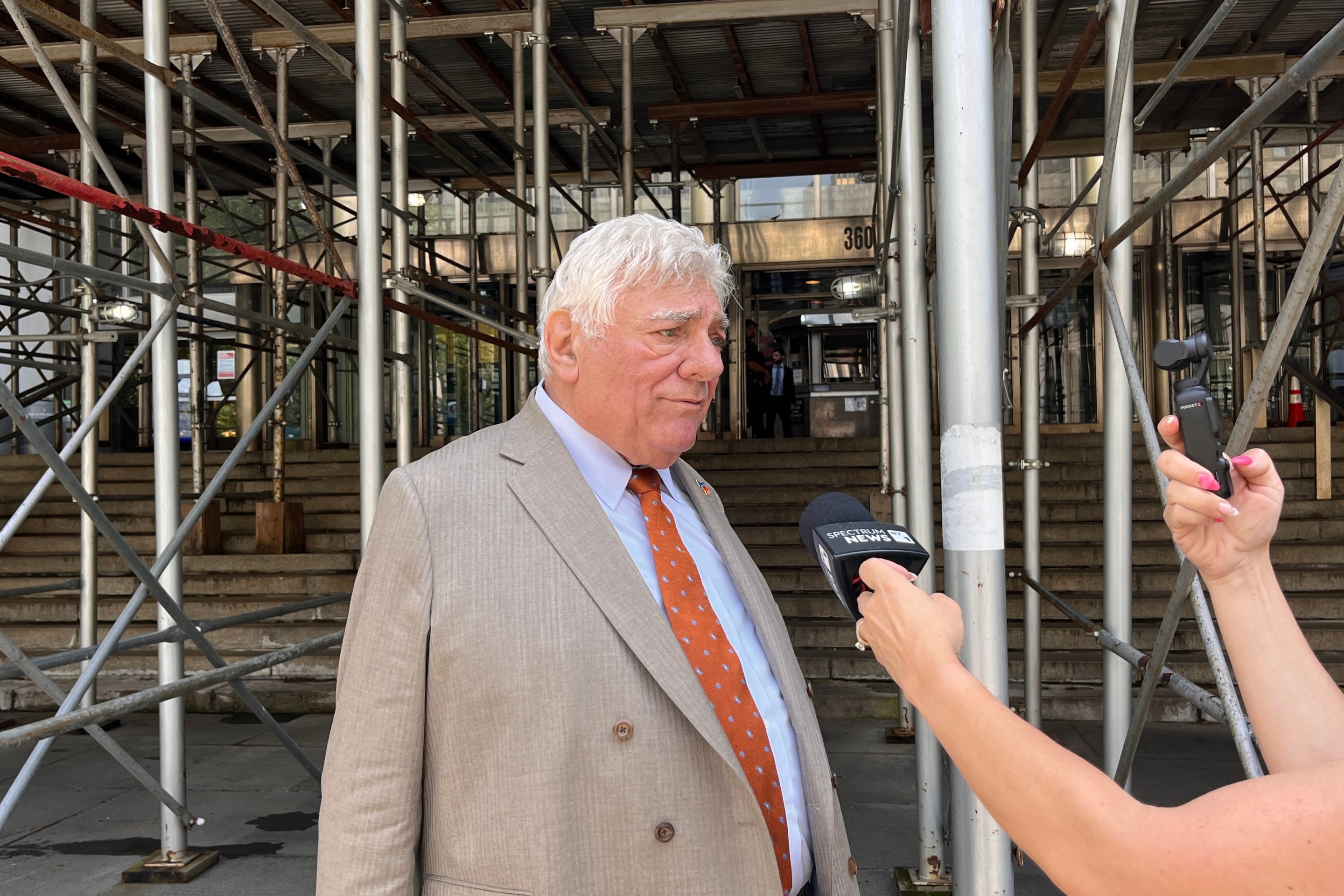The city must follow London's lead in expanding its bike network before congestion pricing kicks in in 2021, bike advocates charged Thursday in midtown Manhattan.
City and state officials need to redirect their focus from who will be granted congestion pricing toll exemptions to thinking about creating safe and alternative modes of transportation for all of the people who are expected to abandon their four-wheelers for two-wheelers in order to avoid the toll — London saw an 83-percent increase in cycling in the four years following its implementation of congestion pricing in 2003. There's no excuse for the de Blasio administration not to create the same safe-cycling infrastructure.
"We want a piece of the action in the form of space on the streets for a much better bike network," said Bike New York’s Jon Orcutt.
Bike New York and Transportation Alternative leaders stood at the corner of Sixth Avenue and 35th Street — where the Sixth Avenue bike lane turns into no man’s land — to blast the city for allowing major gaps in the bike network, including a large swath of Second Avenue between 43rd Street to 34th Street, the Central Park loop drive to the Hudson River Greenway, 6th Avenue from 35th to 59th Streets, and all the way down to Bowery and East Broadway between Park Row and the Manhattan Bridge.
“It turns into a hellish environment for cyclists in the course of a split second. We need the city to step up," said Orcutt.
State legislators back in April historically passed congestion pricing, which authorizes a toll on drivers who enter Manhattan’s central business district below 61st Street. Benefits of the toll are twofold — it's expected to raise $1 billion each year to fund the MTA’s capital expenditures and reduce traffic in an overwhelmingly congested area. But it’s also the perfect opportunity to install more protected bike lanes and fill in gaps in the network since fewer cars on the road means more room for cyclists who are now forced to share space with trucks and cars.
“This only happens once and so we need to take advantage of it,” said Orcutt. “The city is constantly saying high traffic volumes keep us from extending bike lanes past the Midtown Tunnel.”
“Congestion pricing is going to free up more space on the street, and there will be no excuse to use that space for better bike lanes... better bike lanes means more families choosing to bike, and fewer people being struck and killed by drivers,” @marco_conner says. pic.twitter.com/KET5ZCHiyz
— Transportation Alternatives *Vote on Sammy's Law* (@TransAlt) June 6, 2019
Some of the most popular bike paths in the city, including ones within the central business district, have no safe way to get there, said Transportation Alternatives co–deputy director Marco Conner.
"We have to start preparing for the bike infrastructure we need now. We need more than just refugees of safe spaces, we need to get to places like the Hudson River Greenway and Central Park safely," said Conner.
Advocates unveiled a list of streets ripe for protected bike lanes in and around the central business district. They include:
- Extend the protected bike lane network into West and Central Harlem
- Protected bike lanes on Northern Boulevard from Grand Central Parkway to Queens Plaza
- Protected bike lane connection between the Pulaski and Queensboro Bridges
- Redesign the Vernon Boulevard protected bike lane so it does not abruptly switch back and forth between sides of the avenue
- Extend Skillman Avenue protected lanes to the area of Pulaski Bridge
- Protected bike lanes on Thomson Ave to calm vehicle traffic exiting the Queensboro Bridge and provide safety for cyclists and pedestrians
- Additional protected routes through or around Downtown Brooklyn; for example, extending protected lanes along Adams Street/Boerum Place south from the Brooklyn Bridge promenade, completing the Jay/Smith Streets protected bike lane to Atlantic Avenue, and connecting bridge entrances and the pending 4th Avenue protected bike lane via a protected route on Ashland Place and Navy Street
- Protected bike lanes along Flatbush Avenue between Empire Boulevard and the Manhattan Bridge
Other suggestions that would complement expanding the bike network ahead of congestion pricing include more space for walking to create higher-functioning bike lane, including on 8th Avenue in the 30s and 40s, and creating a separated cycling and walking path on the Queensboro Bridge.
They also called for converting standard unprotected bike lanes into protected lanes on the following routes:
- Manhattan cross-town bike lanes in the 40s
- East Houston Street
- Lafayette Street from SoHo to City Hall (southbound)
- 6th Avenue from 35th-42nd Street (northbound)
- Hudson Street from Canal St to Clarkson St (northbound)
- Avenue C and Madison Street in the East Village/Lower East Side
- Bi-Directional protected bike lanes on Avenue B
- St. Nicholas Avenue north of 116th Street
- The Dyckman Street bike lane should be reinstalled
- In Brooklyn, Bedford Avenue between Atlantic and Flushing, DeKalb Ave, Bergen Street east of Carlton, 3rd Avenue south of Carroll
Department of Transportation spokesman Scott Gastel said the agency was indeed preparing for the start of congestion pricing.
"We looked at cities such as London and Stockholm and what they have done to reclaim space and the benefits they’ve seen from congestion pricing," Gastel said. "New York City could see tremendous quality of life benefits, mobility enhancements and transformative possibilities if congestion pricing is done well here."
The agency statement continued:
DOT continues to aggressively build out our bike lane network in Manhattan, including crosstown lanes built last year and more to be added this year. We also made significant advancements in filling in gaps along the borough’s north-south avenues. Effective congestion pricing would allow us to realize more of these enhancements and lead to further development of the bike lane network. We look forward to this opportunity and toward working with advocates to accomplish these goals.






